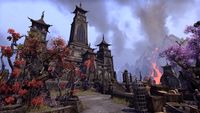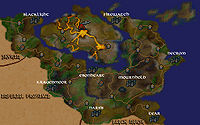Lore:Ebonheart
Este artigo é sobre the city on the mainland. Para the castle on Vvardenfell, veja Castle Ebonheart.
| Ebonheart | |
|---|---|
| Type | Settlement |
| Continent | Tamriel |
| Province | Morrowind |
| Region | Stonefalls |
| Appears in | Arena, ESO |

Ebonheart, also known as the Black City, is a city on the mainland of Morrowind, along the southern coastline of the Inner Sea. Originally, Ebonheart was to be the capital of the Province of Morrowind, but for unknown reasons it split into two separate city-states, which would become known as Ebonheart and Mournhold respectively. The two cities were great rivals, and Ebonheart lost its political power when Mournhold was rebuilt after its destruction by Mehrunes Dagon in 1E 2920 and declared the capital. The city was further shamed when the Staff of Chaos was entrusted to Mournhold. It is often assumed that Sotha Sil's Clockwork City is located somewhere beneath Ebonheart. Three shrines to Almsivi surround the city, forming a sacred triangle.
In the mid-Second Era, Ebonheart was a small trade city controlled by House Dres. The treaties that founded the Ebonheart Pact were signed in the city in 2E 572, after the forces of Ada'Soom Dir-Kamal were defeated nearby by the armies of Morrowind, Eastern Skyrim, and Black Marsh. Following the manumission of Argonian slaves, the marshy ground north of the city was transformed into an Argonian quarter, with mud huts and the city's own Hist sapling. Ashlanders often camped outside the city to trade, alongside Nord lumberjacks who brought wood from Eastmarch. In 2E 582, the invading Daggerfall Covenant threatened to attack Ebonheart. Its diverse population proved to be a problem when a Covenant-funded plot tried to create tension between the three races. However, the citizens were united and the plot was revealed.
During the Imperial Simulacrum, the city under King Casik was at war with Firewatch. The Eternal Champion came to the city searching for the location of Dagoth-Ur. King Casik, who possessed the Anvil of Mithas, offered the hero aid in return for the Hammer of Gharen, the only object strong enough not to shatter when used with the Anvil. The Hammer had been lost in the nearby dungeon of Black Gate, southeast of town. When the Hammer was used upon the Anvil, the ringing would reveal the long lost entrance to Dagoth-Ur. The hero recovered the Hammer—which King Casik used to create the finest weapons and armor in the realm—and learned the location of Dagoth-Ur, which contained the final piece of the shattered Staff of Chaos.
The name of the city was adopted for the new Imperial capital of Vvardenfell, Castle Ebonheart, built sometime after the island was opened for settlement in 3E 414. Due to Ebonheart's proximity to Vivec City, it can be assumed that the falling of Baar Dau and the subsequent natural disasters and Argonian invasion in the early Fourth Era damaged the city greatly, perhaps fatally. Umbriel likely passed over the city circa 4E 40, which would have turned any remaining populace into undead.
Notes
- Arena was originally conceived as a fighting game featuring a tournament that took the player to each of Tamriel's cities to challenge different gladiatorial teams. According to a file from that stage of development left behind in the final game, Ebonheart's gladiatorial team would have been called "the Reavers".
References
Nota: as seguintes referências não são encontradas no jogo. Elas são incluídas para providenciar um fundo mais sólido ao artigo, mas podem não refletir lore estabelecida.
